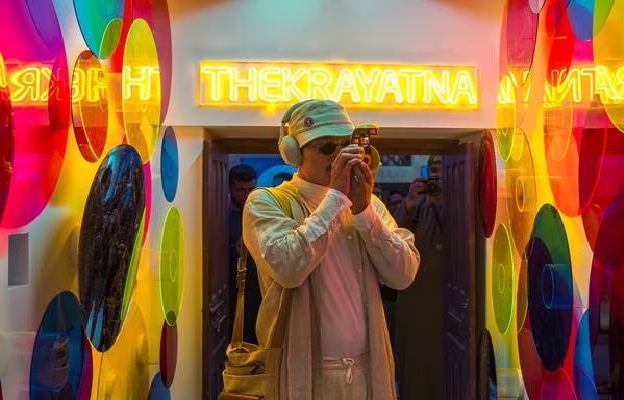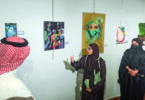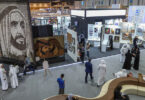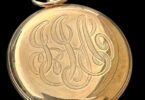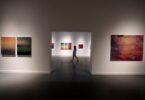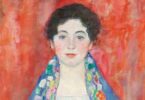Razmig Bedirian
Passengers flying with Emirates and Etihad Airways can now explore some of the region’s finest in-flight artists thanks to the Khaleeji Art Museum, a digital institution dedicated to artists from the Gulf.
Its Museum in the Sky project announced a second batch of artists in May, featuring five from the Gulf – Jalal Luqman, Sumayyah Al Suwaidi, Ishaq Madan, Maitha Hamdan and Mohammed Al Attar. Passengers on Emirates can also hear from the creatives as they share their artistic journeys and elaborate on some of their works.
“We were inspired to launch Museum in the Sky in 2021,” says Manar Alhinai, who founded Khaleeji Art Museum with sister Sharifah the year prior.
:quality(70)/cloudfront-eu-central-1.images.arcpublishing.com/thenational/JP3NZ5CFENAQXEYZTEJML4PQPU.png)
“Since planes carry such diverse populations, millions of whom are driven to travel out of a sense of curiosity about various areas of the world, their people, cultures and more, we thought it would be a great place for us to provide more insight about our rich region through its art and artists.”
Sharifah says: “In its first volume, four Emirati and UAE-based multidisciplinary artists – eL Seed, Nujoom Al-Ghanem, Hussain AlMoosawi and Maitha Abdalla – recount their creative beginnings and walk viewers through three of their most memorable works of art in their galleries in the sky.
“We reached out to the artists. We make sure that we present works by artists who work across different mediums, as well as to present works by both established and emerging artists.”
Manar adds that she and her sister believe digital to be one of the most effective ways to promote art. “We always explore different ways to do that within the digital sphere,” Manar says.
When the two sisters set out to establish a digital art museum dedicated to artists from around the Gulf, they were responding to a request they often heard as professionals in the creative industry.
As the founders of Sekka – a London-based publication centred on the arts, culture and literature of the Arab World – the sisters often met and worked with creatives from the region who, “time and time again, expressed to us their wishes of having an art platform that would provide them with the opportunity to showcase their work to a global audience”.
“We especially heard this from emerging artists,” Manar says. “Through Sekka, we gave many of them a platform through media, but in our hearts, we knew that more could be done.”
Enter the Khaleeji Art Museum. Encompassing pop-up initiatives and virtual exhibitions, it has since been featured in the most unlikely of places – including the in-flight entertainment systems of Emirates and Etihad.
:quality(70)/cloudfront-eu-central-1.images.arcpublishing.com/thenational/KP5J44BVL5A7ZLZ36CMDGEIESA.JPG)
Established in 2020, during the thick of the pandemic, Khaleeji Art Museum was born when cultural institutions across the world were scuffling to overcome the challenges of the time.
“The cultural and creative sectors were negatively impacted [by the pandemic] and were among the worst hit,” Sharifah says.
“Being art enthusiasts, my sister and I had missed going to art exhibitions and institutions because of lockdown and social distancing, and we remembered what artists had told us over the years.”
As a response, the sisters decided to launch an online art exhibition on their Sekka website in April 2020. It was a precursor to the Khaleeji Art Museum. The aim of the exhibition was to give artists from the Gulf a platform to show their work to an international audience at a time when in-person events were restricted. The theme and title of the exhibition was Khaleejis in the Time of Corona.
“We chose this theme because it was important for us to document and showcase how the people of the Arab Gulf states were experiencing this unique period,” Manar says. “We put out an open call and received a multitude of submissions, and within a month after we launched the exhibition we showed the work of many emerging artists from the region who work with a range of mediums.”
The exhibition included works by artists from the UAE, Saudi Arabia, Bahrain, Kuwait and Oman. The works were presented in a range of media, from photography and digital art to acrylic on paper and canvas, as well as mixed media.
The exhibition, Manar adds, was seen more than 10,000 times by visitors from across the world. Its popularity inspired the sisters to build upon the idea of creating an online experience, this time through a dedicated platform.
The Khaleeji Art Museum was officially established a month later, on May 18, 2020, coinciding with International Museums Day.
:quality(70)/cloudfront-eu-central-1.images.arcpublishing.com/thenational/QBISZSSFT5GGRDDJTF4SUJO5NA.jpg)
“We are proud that our museum is not merely the region’s first digital museum dedicated to exhibiting arts from the Arab Gulf states, but that it has been entirely developed by an all-women team,” Sharifah says. “Everything from our brand identity to our digital infrastructure was designed and developed by women from the GCC.”
Since its Khaleejis in the Time of Corona exhibition, which ran until a week after the institution was established, Khaleeji Art Museum has spearheaded a handful of digital exhibitions, each of which was held under a specific theme.
Ramadan in Quarantine was the theme of the museum’s second exhibition, running from May to June 2020. Like its predecessor, the exhibition highlighted how people in the region were navigating pandemic restrictions, this time with a focus on the Holy Month.
:quality(70)/cloudfront-eu-central-1.images.arcpublishing.com/thenational/D25SFN36RREP7BLUREZBBHVEMM.JPEG)
Art for Change, meanwhile, was held from August to December 2020, and reflected on the transformative effects of the pandemic and how artists felt about change.
Enough is Enough, running from March to July 2021, brought the works of a dozen artists from the Gulf that addressed the various forms of sexual harassment and assault.
Transcendence, on the other hand, dealt with notions of spirituality and was curated from darker works to lighter ones, reflecting on the journey beyond physical being.
Khaleeji Art Museum also aims to make the collections of regional art collectors more accessible. This initiative began with a collaboration with Zaki Nusseibeh, cultural adviser to the UAE President.
Nusseibeh’s collection, which was acquired over the course of five decades, is “a distinguished example of Arab collecting,” Sharifah says. It spans three centuries of eastern and western art with some 700 works that include drawings, paintings, sculptures, manuscripts, installation art and multimedia art.
:quality(70)/cloudfront-eu-central-1.images.arcpublishing.com/thenational/UOA6ZRFM6ZBWHN5EU6HEVUHNQA.jpeg)
“His Excellency opened up his private museum in his Al Ain home, where a part of his collection lives, to the Khaleeji Art Museum to photograph and digitally exhibit over 100 artworks that reflect the religion, politics and society of the MENASA and beyond, and themes such as conflict and love,” Sharifah says.
“This marks the first time that this vast number of artworks from His Excellency’s collection has been made available to the public at once, and in digital format.”
The initiative is likely to continue, Sharifah says, adding that the museum is in the process of collaborating with other Arab collectors.
Courtesy: thenationalnews

